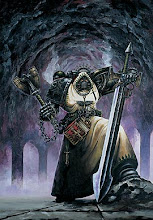Titan configurations present a wide variety of often confusing nomenclature. This is a product of two main circumstance:
First, the models have evolved quite significantly since their introduction originally in Adeptus Titanicus; that game introduced only one broad type of Titan, but we now have about twenty.
Second, Games Workshop has been...ambiguous in sorting things out and, on at least one occasion, made obvious errors. Now the ambiguity helps to reinforce the mysterious elements of 40k, but simple errors could have been avoided.
I. TYPE
Broadly speaking, the first and most important distinction between Titans is their Type. Since most of the 40k universe is presented through the eyes of the Imperium, they get to label the Types. They are:
Emperor - the largest and rarest type, Emperor Titans are mammoth.
Battle - the most common type, Battle Titans perform a variety of battlefield roles and do the majority of the fighting.
Scout - the lightest type, Scout Titans perform in a reconaissance and support role.
II. CLASS
Within each type, there are subdivisions. Essentially, this is a matter of the basic "chassis".
The Imperium fields 4 (or possibly 5) different Classes of Titan. They are:
Imperator (Emperor type)
Warlord (Battle type)
Reaver (Battle type)
Warhound (Scout type)
The possible fifth class is the Warmonger. This monster is an Emperor type Titan; however, it is not clear if it is a variant of the Imperator, or a unique chassis. There are important similarities and differences between the two.
III. PATTERN
Various classes of Titans are produced throughout the Imperium. As a consequence of STC technology, the same essential Titan could be built by a variety of forge worlds. However, because of the fallen state of the Imperium, a number of cosmetic and even systemic differences can exist between the same class of Titan.
The most obvious Pattern disticntion is that between Mars and Lucius pattern Titans. Mars-produced Titans tend to have rounded carapaces and armour plates, whereas Lucius-produced Titans tend to be more angular and slab-sided.
HOWEVER, this analysis is complicated by the fact that Epic: Armageddon and Jervis Johnson indicate that "pattern" refers to weapons loadout, rather than cosmetic appearance or place of origin. This position should be discarded as grossly inconsistent with Forge World's various conversion kits (Ryza pattern turrets) and essentially the entirety of the rest of what we know about Titan classification.
IV. MARK
Because GW's modelling technology has advanced over time, and they have withdrawn and reintroduced models, "Mark" has emerged as a way of distinguishing earlier/later versions of the same model. The Armorcast Warhound, with it's rounded carapace, is clearly a Mars-pattern; Forge World's most recent smooth armoured Warhound is also Mars-pattern, hence Mark 1 and Mark 2.
V. VARIANT
Variant refers to weapon and equipment loadout. In Adeptus Titanicus, this was a very important classification, but it has diminished in importance over time as more Titans' were introduced to the game. Since in Adeptus Titanicus there was only one class of Titan in the box, these could be configured differently to create light, medium, and heavy versions. As the Reaver and Warhound were introduced, these roles were filled by dedicated Titan classes, and so variants become much less of an issue. Nonetheless, some weapon variations are so common that they have been standardized as named variants.
Imperial Titans appear in the following variants:
Warlord Nightgaunt - Assault weapons [Laser Burners, CCWs]
Warlord Nemesis - Support weapons
Warlord Eclipse - Relics
Warlord Deathbringer - Tactical weapons
Reaver Vandal - Relics [Devotional Bells, etc]
Reaver Hun - Tactical weapons [Gatling Blasters, Turbolasers]
Reaver Goth - Support weapons [Vortex Missiles, Deathstrike Cannons]
Warhound Wolf - Anti-Tank weapons [Plasma Blastgun & Turbolaser]
Warhound Jackal - Anti-Infantry weapons [Inferno Gun & Vulcan Megabolter]
It could be argued that the Warmonger is in fact a variant of the Imperator, given that much of the structure is identical, but for the weapons load.
22 November 2010
Subscribe to:
Posts (Atom)
